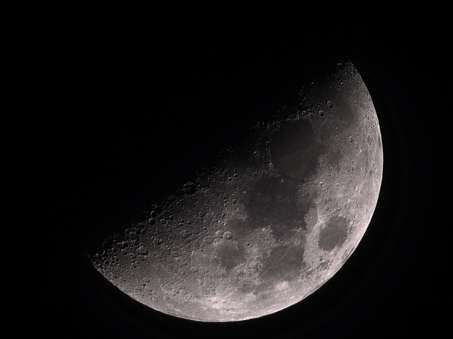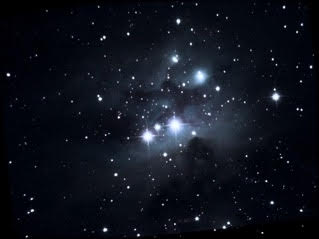April offers the BEST opportunity to observe Mercury in 2025 and the Lyrids Meteor shower is an unmissable annual event, Unistellar reveals
April is set to be an exciting month for skygazers, with opportunities to witness the full Moon, planetary alignment and meteor showers. UNISTELLAR, the pioneer and market leader in smart telescopes, calls upon amateur astronomers to observe the night sky and offers some tips on how to enjoy the best astronomical events in April.
1. 13 April: Full Moon (Micromoon)
The Full Moon will light up the night sky on April 13 at 00:22 BST. During this time, the Moon will be positioned in the constellation Virgo. While the Full Moon is an exact moment when it sits directly opposite the Sun, it will appear fully illuminated to the naked eye for about a day before and after. This particular Full Moon will be a Micromoon, meaning it will be slightly smaller and dimmer than usual—5.1% smaller and 11% less bright compared to an average Full Moon.
Observation tips
● Use a telescope to photograph the Moon with crisp detail.
● Don’t wait for the full Moon, the best time to get a clear view of the surface of the Moon is during the ‘First Quarter’ phase when you can see the valleys and craters.
● A higher elevation or an area with an unobstructed horizon will offer a clearer view of the Moon as it rises.
2. 17 April: Four planets in the planetary alignment
Four planets—Neptune, Mercury, Saturn, and Venus—will line up in the early morning sky. This typically happens every few years, depending on the planets involved and their orbits.
Observation tips
● While Mercury, Saturn, and Venus will be bright enough to spot without any special equipment, Neptune will require a telescope or powerful binoculars to be seen.
● Check the weather forecast for clear skies.
● Use a telescope to identify the planets more easily.
3. 21 April: Mercury at greatest elongation west (the best in 2025)
On April 21, Mercury will reach its greatest western elongation, appearing at its maximum distance from the Sun in the morning sky—about 27°24′ apart. Mercury is usually hard to spot since it orbits so close to the Sun, so this will be a rare opportunity to see it this year.
Observation tips
● Shining at approximately 30-60 minutes before dawn will be one of the best opportunities to spot Mercury.
● Look for Saturn and Venus nearby, as they will also be visible during this time.
● Use binoculars if you have trouble spotting Mercury—just be sure to stop looking once the Sun rises to avoid eye damage.

Credit: Author: Scott Kardel | Unistellar, shot with Unistellar OdysseyPro
4. 22 April: Lyrids Meteor shower
The Lyrids peak on 22 April but will be visible on the nights either side of this date. The Lyrid meteor shower, active from April 14 to April 30, has a peak rate of about 18 meteors per hour. The waning Moon will be illuminated to 38% during this period, which may slightly affect visibility, but the meteors will still be observable. The radiant point for the Lyrids is located in the constellation Lyra, and this shower can be seen from virtually anywhere on Earth. The Lyrid meteor shower is classified as a moderate-strength event, sometimes producing bright fireballs.
Observation tips
● For the best chance of spotting meteors, it’s recommended to begin observing after 10:30 PM local time (approximately 2 hours after sunset) in northern latitudes and after midnight in southern regions when it’s completely dark.
● Check the weather conditions: this year the viewing conditions should be favorable, with the waning crescent Moon having minimal impact on visibility.
● Prepare a hot drink and blankets, relax and don’t focus your eyes anywhere in particular, just let your peripheral vision wander to fully enjoy the show.
Franck Marchis, astronomer at SETI Institute and Co-founder of Unistellar: “Meteor showers are visible from various locations around the world. During the peak nights of the Lyrids, observers in the UK can expect to see up to 100 meteors per hour, provided the skies are clear and dark. The infamous Lyrid meteor shower is caused by debris from a comet entering Earth’s atmosphere and burning up, creating the visible streaks of light.”
5. 27 April: New Moon
During the New Moon phase, the Moon will be positioned between the Earth and the Sun, with its illuminated side facing away from us. This makes it an ideal time for stargazing, as the Moon’s light won’t interfere with the view of other celestial objects.
Observation tips
● With no moonlight, the sky is at its darkest, making it ideal for viewing faint celestial objects. It’s a perfect time to observe galaxies, nebulae, and star clusters that are usually washed out by the Moon’s brightness.
● Use a red torch instead of a regular one to preserve night vision.
● This is also the ideal time to enjoy your telescope, especially if it’s designed tailored for deep-sky observations like galaxies, nebulae and also comets.
